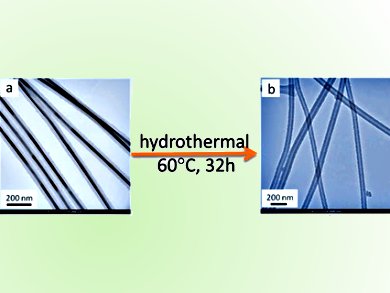Xuchuan Jiang, The University of New South Wales, Sydney, NSW, Australia, and colleagues have developed a facile and efficient hydrothermal method for the direct synthesis of both carbonaceous silver (Ag@C core–shell) nanocables and carbonaceous nanotubes under mild conditions (<180 °C). The carbonaceous tubes were formed by removal of the silver cores via an etching process under temperature control (60–140 °C) without any additional etchant(s).
The team found that cetyltrimethylammonium bromide (CTAB) plays multiple roles in the formation of Ag@C nanocables and carbonaceous nanotubes including: (i) a shape controller for metallic Ag wires and Ag@C cables, (ii) a source of Br− ions to form insoluble AgBr and then Ag crystals, (iii) an etching agent of silver cores to form carbonaceous tubes, and (iv) an inducer to fill silver particles into the carbonaceous tubes to form core–shell structures.
In addition, the carbonaceous nanostructures show potential applications in electrochemical catalysis in the oxygen reduction reaction (ORR). By controlling the etching of Ag core within the carbonaceous sheath, it is possible to adjust the Ag nanoparticle size to achieve an optimum ORR activity. Cost is much lower than for the commonly used platinum catalyst.
This simple but effective synthesis of novel carbonaceous nanostructures with various dimensions, e.g., nanocables, yolk–shell nanospheres, and hollow structures, may be used for sensor, electrocatalyst and biomedicine applications.
- Direct Hydrothermal Synthesis of Carbonaceous Silver Nanocables for Electrocatalytic Applications,
Chuyang Chen, Bryan Harry Rahmat Suryanto, Chuan Zhao, Xuchuan Jiang, Aibing Yu,
Small 2015.
DOI: 10.1002/smll.201401854




